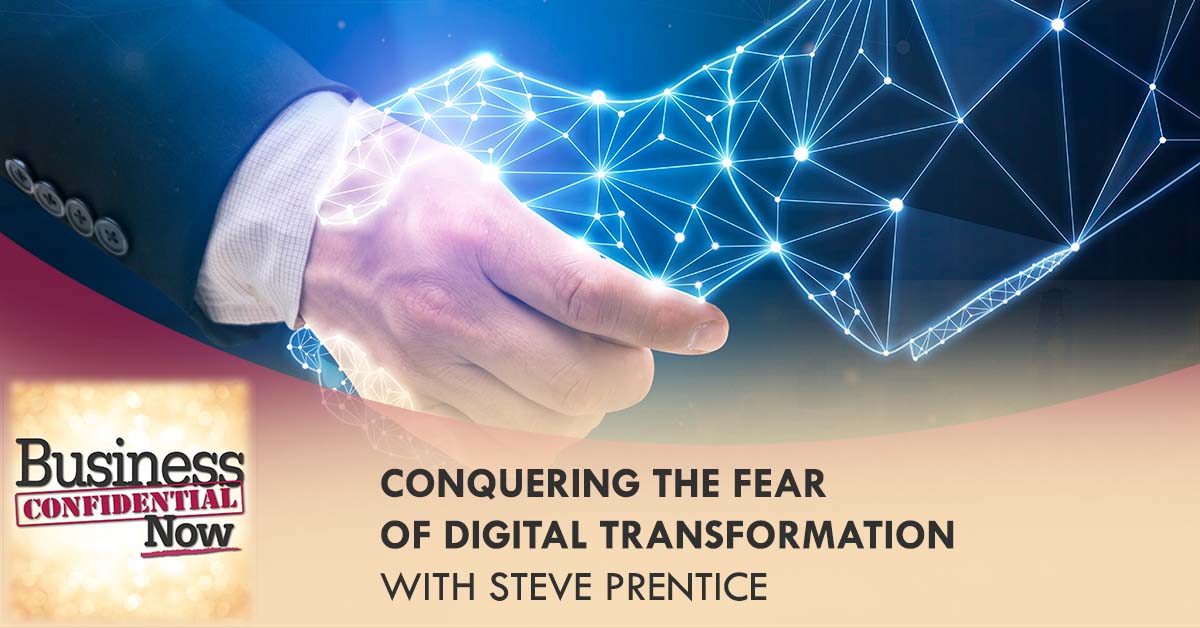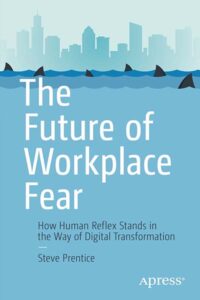
Photo Credit: © iStock | jittawit.21
With change comes insecurities, doubt, distrust, and resistance. And in this age of digital transformation when change is becoming constant, it takes more than will to overcome the fear of the unknown. In this episode, Steve Prentice talks about the different issues resulting from fear of digital transformation and how leadership plays into driving awareness and providing support to help the workforce not just cope but thrive in an evolving workplace.
—
What You’ll Discover About Conquering The Fear Of Digital Transformation
- Different generations face different challenges and fears of digital transformation
- The important role that management plays in avoiding issues brought about by the fear of digital transformation in the workplace
- How human nature can get in the way of evolution and digital transformation
- How understanding why people work the way they work can help bridge the gap of awareness on what’s going on in different levels of the organization
- How facts neutralize our fear of digital transformation
GUEST

Steve Prentice is a specialist in organizational psychology, focusing on the junction where people and technology interact. He helps people and organizations understand each other, the technologies they use, and the changes that they present. He is a speaker, writer, journalist, and university lecturer who focuses on human acceptance of cybersecurity, artificial intelligence, blockchain and the future of work. His fourth book is entitled The Future of Workplace Fear – How Human Reflex Stands in the Way of Digital Transformation (Apress, May 9, 2022) and it focuses on this one key fact: humans are driven by fear, and its roots are much deeper than they appear — anyone who seeks to deploy digital transformation successfully must understand this.
—
Conquering The Fear Of Digital Transformation With Steve Prentice
Fear of digital transformation, your workforce’s ability to embrace, learn, and adopt new technology can impact the ability of your organization to thrive in the new economy. What can you do about it? My next guest is a specialist in Organizational Psychology who focuses on the intersection of people in technology, and he’s got some answers for you, so stay tuned.
—
I have a special guest for you in this episode. His name is Steve Prentice. He’s a specialist in Organizational Psychology who helps people in organizations understand each other, the technologies they use, and the changes they represent. He’s a speaker, writer, journalist, and university lecturer who focuses on the human acceptance of cybersecurity, artificial intelligence, blockchain, and the future of work.
His fourth book is entitled The Future of Workplace Fear: How Human Reflex Stands in the Way of Digital Transformation. It focuses on this one key fact. Humans are driven by fear. You may be scared reading this right now, but hang on there. Anybody who’s looking to deploy digital transformation needs to understand this and that’s why we’re all here now. It’s a treat to have him join us. Welcome to the show, Steve.
Thank you. It’s a pleasure to be here.
Yours is a fascinating topic and this nexus between people and the technology they use seems to be changing at such a rapid rate these days. Just so that we’re all on the same page, please help me understand what you mean by digital transformation.
It can mean a lot of things to a lot of different companies, but basically, you’re talking about the technologies that we bring into the business. It’s the computers that we use, the technologies we use to communicate like social media, and moving into things such as working from home but also think about things such as your smart doorbell on the outside of your house. These are all ways that our lives are changing because of technologies that are both intelligent and communicate with each other. They are connected.
This transformation we’re going through right now is one in which we, as people, are working so much more closely with intelligent connected technologies to get our work done. Whether you work in an office or you work in a location with machinery or in a hospital, we’re all facing the same digital transformation right now.
Indeed, we are and it seems to be increasing faster and faster all the time. I think if people misplace their phone, half their life is gone, if not more. Please tell me about the fear of digital transformation that you see happening in organizations. What fears are we talking about?
We’re talking about very basic ones and this is the issue. I’ve been doing this for years since computers came out to become a technology in the workplace. When I was a student at university back then, I had to find some temporary work to help pay the bills. Wherever I work, simply doing database stuff or number crunching, people around me in the office would be worried. “How can I use this? I don’t know what it does. What if my document is lost? Where does it go?”
There was an enormous fear about how the technology works because there was this disconnect between how the computers were designed to work by computer scientists and how the end users were expected to use them. It’s one thing to have to learn how to use any particular technology, even riding a bicycle, but when it comes to technology, the fear of making a mistake, losing your document, and looking stupid in front of your boss and your peers and the ultimate fear of losing your job because you appear to not be able to do the work is what drives people.

Fear Of Digital Transformation: When it comes to technology, the fear of making a mistake, of losing your document, of looking stupid in front of your boss and your peers, and the ultimate fear of losing your job is what drives people and it makes them hide.
It makes them hide. It makes them do things surreptitiously so as to look like they’re learning something, but they’re not. It becomes enormous with how people are using it. It becomes a dangerous thing, not only simply a choice. It’s a great danger to an organization and you can go as far as national security because if one piece of our connection is dead because someone isn’t doing the right thing, we all suffer from that.
I’m sure that there are some readers that could check off a couple of the boxes when you said the document gets lost and gets blamed for it. Let me ask you this though. Why can’t employees get over it? I would imagine that some of the younger cohorts that have grown up with technology are tech-savvy. If anything, they’re fearless about it. They’ll go clicking on all kinds of buttons that my generation might be a little reluctant to. “Let me check first. Let me save this first.” I see a certain fearlessness. Could the opposite be true?
The opposite is true, but there’s fear there too and that’s the interesting thing. There is a digital divide between those who started their work life before the internet and computers came into our lives and those who started afterward. Here we are in an age now where people who are entering the workforce were born after 9/11.
We’re talking about a new generation of people who have grown up with technology in their hands, probably from the first time. In fact, the iPhone is used by a lot of young parents to keep their kids and their babies occupied for a short time. However, the two differences, the two fears are equally destructive for the older generations. As we pointed out, it can be the fear of making a mistake, losing a document, the fear of getting stuck, or even the fear of taking time.
For example, in a person’s own home, you probably have a router. You probably have that device that takes your internet signal and sends it to your computers and then sends everything back out to the internet. How many people have changed the password on their router? Most people don’t even know it exists. For those who have thought about doing it, it could be a scary thing. “What if I make a mistake and my router doesn’t work and there’s no internet in the house? How terrible would that be?”
There’s that fear about having to read the instructions, using technology, and making a mistake in setting it up or even the cost of having someone come in and do it. It doesn’t seem necessary and that’s simply hoping for the best, work with it, and hope that it works but there are a lot of security issues that come from unguarded routers and again, smart doorbells and your phone.
Everything we use, we use with that hope that it’s going to be okay but then you’ve got the other side. You’ve got the younger generation who have grown up with the technologies. One of their greatest fears is direct conversations or communications with other people. When you’ve grown up texting as a primary source of social interaction, I’m not saying it’s a bad thing, but texting is an ultimately controllable conversation device. You type out your entire sentence and you send it.
That’s different from having a dynamic conversation, the way we are having it right now. When young professionals are brought into positions where they have to interface with their manager or they themselves become a manager and they’ve got to learn how to work and communicate with their employees, they realize that that live conversation can be a scary thing because it’s not controllable.
I’m not making this up. These were direct quotes from people who were asked this very question. “I prefer to text because I can control it, but I don’t know what you’re going to say in a conversation and I don’t know where this conversation’s going to go.” That fear immediately degrades the relationship that is so vital between any set of employees and managers in the dynamic of a workplace. In both situations, you’ve got fear getting in the way of the progress that the technology was designed to deliver. That’s the problem.
That’s a succinct way of putting it and that in itself is incredible. Do you see this fear growing?
Yes, it’s growing because there are new changes coming in all the time. Here we are looking at things such as the work-from-home option. We’ve all been through two-plus years of COVID and so many of us were sent home to do our work from home and we learned we could do that. Now comes the issue of, “Do I go back to work with people who may be, again, physically dangerous to me in terms of being COVID carriers or other variants and so forth?”
You’ve got managers who say, “If my employees are working from home, then how do I trust them to do their work?” which is a crazy concept and I could spend an hour with you on that. The default reaction is, “How can I trust an employee I can’t see?” That’s where many managers are at for these reasons. Again, it’s not a controllable relationship if you’re not there down the hallway from my office. You’ve got the fear of loss of what we had before.
If you were used to working in a particular location, in a particular building with a particular desk and office in a cubicle and that has now gone and your floor has now been replaced by a hoteling and hot desking thing where you have to book a desk for those days you come in. “I don’t like that. That’s changed. That’s not how it used to be. I want what we had before,” is the response they’ll have. “I don’t like this new lifestyle and I’m going to resist it.”
The fear is not necessarily only about how to use technology, it’s also the fear of the loss of the status quo. Human beings instinctively do not like change because change means a threat to your stability and your safety. Not only are we looking at the fear of looking stupid in front of our peers and our managers, but we’re also looking at the ultimate human fear of change. We don’t like change because it represents, on a purely instinctive level, some new element that could be dangerous to us.
Human beings instinctively do not like change because change means a threat to their stability and safety. Share on XAgain, that is a big chasm between those who design the new workplace and those who are forced to accept it. Many may accept it grudgingly, but under the surface, they will not cooperate fully. They unconsciously may sabotage the system through their lack of desire to participate. That too is very dangerous.
Is there anything management can do to plan their digital transformation? Digital transformation is inevitable and it’s going to be ongoing and continuous with every new beeping device that gets created, an app. Is there any way they can plan digital transformation in a way that avoids the problems brought about by these different workplace fears? What advice do you have?
They can. That’s why management is a one-word term. It’s about managing how your company operates. There’s so much they can do to thrive and not only keep the company safe but also have happy employees, engaged employees, and employees who are willing to stay. Remember, we are far more empowered now as employees than we were even a decade ago in terms of knowing that there are other jobs out there.
Despite the headlines saying that there are economic issues going on, there’s always other work out there. Managers need to recognize that to attract and retain employees, we’ve got to create a workspace that is conducive to how they want to work now. The answer is yes. All management has to do is modify the culture to embrace these new habits. What do I mean by that?

Fear Of Digital Transformation: Managers need to recognize that to attract and retain employees, they have to create a workspace that is conducive to how they want to work today.
If you have new technology and the one that I like to use the most is the notion of password management software. It sounds technical, but the point is that you got to maintain your passwords when you’re working in an office or at home. If you are a nurse or an accountant, it doesn’t matter. Whatever you do as a job, you are interfacing with a network in your employer’s company.
If you do not maintain passwords safely, all kinds of bad stuff happen through cybercrime. This is a big area that I work in most of the time. How do you get people to want to use password management software and use it correctly? All you’ve got to do in management is give them the time to learn properly. That’s the big change. Over the last few decades, if you had to learn something as an employee, you were sent to a workshop or to a training session. I know because I’ve delivered many of them myself.
It’s unfair to expect people to learn skills after sitting in the classroom for 1 hour or 6 hours. Most of what they hear and see will evaporate within 24 hours because humans don’t learn like that. You’ve got to change the way that people learn how to use technologies to try it out bit by bit, iteratively, and hands-on in the way that you learn.
If you’ve ever learned a new language, a second language, for example, you don’t learn the whole language in a day. You learn little bits at a time. If you watch a child learn how to speak, as an infant, they learn little bits at a time. That’s how we do it. Management can easily resolve all these problems simply by modifying them. That doesn’t mean a wholesale change, but fine-tuning the way that they help their employees feel comfortable with the new technologies or the new techniques.
Whether it is password management software, a new way of hoteling, hot desking in the office, a hybrid work scenario, or any other regular, old normal that they want to bring back, we have to change the way that humans are given the time to learn and practice. I have one more brief example for you. Imagine, for example, phishing emails. You hear this all the time of people clicking on an email that brings malware into the organization.
The main culprit there is not the email. It’s the fact that employees feel so rushed that they have to click on this thing and get it done before they get in trouble for spending too much time. They’re under such pressure to get work done that they click out of haste. That has to be removed. Give people the chance to take their time and do things right and you will eliminate so many costly mistakes and so many examples of attrition or simply employee migration. You’ll generate a much stronger workforce and a stronger company for this new decade.
That all makes a lot of sense. Why aren’t more managers doing that when they’re engaging in digital transformation?
Once again, one word, fear. On one level, you’ve got the fear of looking stupid. Why didn’t you do this before? If you are the manager, why didn’t you do this before? Now, you look stupid for not having done this in the first place. If you do decide to put your neck out and say, “We should make these modifications,” now you’re going to get blowback from senior management and say, “This is going to cost us too much money. We don’t have the budget for this training. We can’t do this stuff. Why don’t we go back to how it was?”
There you’ve got layer upon layer of fear because if now as a manager, you try to put this forward, and to be fair, there are many managers out there who love their team. They want to make their team successful. It isn’t like all managers are bad, but they’re trapped between the needs of their employees and the demands and expectations of their senior management and their board of directors who are most interested in the long-term vision for the company and maximizing profits if it’s in the private sector, or simply maximizing efficiency, even in public sector areas.
Sadly, many of the people in these senior positions don’t have the time to learn enough about whether it’s a cybersecurity issue or simply a workplace issue. They don’t have enough time to learn or interest to learn and nor do they themselves want to look ignorant if they own up to the fact that they don’t know what cybersecurity is or what a particular threat happens to be.
You’ve got fear all the way up the ladder right to the C-Suite. Individual fears that together compound to make for a very dangerous situation. Why can’t it be done? It’s because everybody is afraid of either looking stupid, costing too much money, or making change happen. Why can’t we go back to the way things were? Sadly, the old normal will never return.
We had film companies in the 1970s and 1980s that went out of business because they didn’t want to go digital. The same thing’s going to happen to many organizations whose products may be excellent, but because they haven’t been given the opportunity to embrace change within the organization, will go the way of so many other faded brands by not changing quickly enough.
It all boils down to maintaining competitiveness and there’s no way to snap the board of directors or senior management, the C-Suite out of this to say, “You can’t possibly know everything. Let us help you. This is an investment you need to make in order to leapfrog these products.” They don’t want to get that?
That’s been a problem for many decades. Once you get to those levels, profitability and shareholder value are key issues, but once again, there’s a gap there. I can explain that shareholder value is based on the longevity of an organization. That’s investment 101 but the point is that the longevity concepts are still stuck two decades past. We’ll set a ten-year plan for the company. We can do a ten-year plan, but you’ve also got to have a ten-month plan because that’s how quickly things are changing.
All of these fears that we’ve discussed can be fixed, but we’ve got to replace the element of fear, which by the way, is an emotion. This is an emotional side of the human self with the facts of how to do it. If you think for example, about a child who’s afraid to go to sleep at night because they think there’s a monster under the bed, we all know that kind of story. What do you do to prove to the child that there’s no monster under the bed? You show them under the bed. You get a flashlight and you show them there’s nothing there.
These kinds of things are what we need to do for grownups as well. We need the facts to show them how to use technology or how to change their company in order to embrace what’s going on. The concepts that they embrace generally are always filtered first through emotion and logic always spend time trying to catch up. There’s a simple solution to all of this. It’s what I call bringing the facts up to meet the fear. You have to neutralize fear with facts.
Bring the facts up to neutralize fear. Share on XIn a training situation, it is showing somebody how to use something iteratively. On a C-Suite level strategic way, it is by demonstrating, for example, how a single person working from their home for the company using a particular third-party storage device to store their files can become the cause of ransomware. They can bring the company to its needs for a year or more with one simple dismissal of a security policy.
People don’t want to grasp that detail because it seems too scary. That’s what we had to deal with. Bringing the facts up to meet the fear. How are you going to fix this time, training, and a modified way of managing people so that they can learn these skills and feel good about it? It’s very easy and it costs pretty much nothing because it’s only a matter of using company time in a different way.
They can do it right in the first place or they can learn to do it over. You mentioned something that piqued my curiosity about when employees are fearful of digital transformation and maybe they’re already in the middle of a transformation and how they could be sabotaging it. If you’re in management and you have a digital transformation in progress, or maybe you think it’s already happened, but it hasn’t because employees may be undermining it somehow, how do you know?
Once again, it depends. We’ve got to look at which things we need to know about. How do you know what you don’t know? It starts with the expectation that these things can happen. I’ll give you one specific example. It’s annoying when people get this notification that says it’s time to change their password again. Some people get it every couple of weeks. You got to change your password. People don’t like changing passwords so they’ll either ignore it or they’ll simply leave the current password and add a one or an exclamation point at the end.
That isn’t fixing the problem because they’re not aware that the bad guys out there know a lot about this. They know people do this and so they simply search for passwords with an exclamation point at the end. They know this, but others will grudgingly change the password to something much longer and more complicated and then the moment that the IT people turn their backs, they will turn it back. They’ll do what they’re told to and then as soon as the IT people have left the room, they’ll change it back to the old password, which is a lot easier.
That’s a classic human thing to do. It’s only a matter of once a teacher walks by, you pretend you’re writing your exam and then you go back to whatever once they’re gone. You’ve got to know that these things happen. You cannot rely on people to simply sit down and do what you ask them to do. It isn’t because they don’t like you or like the company, but because they’re afraid of getting it wrong or they’re afraid of the repercussions if they can’t remember their password. Now, they’ve got a call to the help desk, and so on.
I’m using a lot of passwords in cybersecurity examples, but they can spread to any area where people work. If they don’t want to do something, the natural desire is to just hide it and do it the way they used to. It’s like smoking in the washroom. It was a big problem for a lot of people for a long time. After smoking, laws were passed. They would still sneak their way into smoking. It still happens to this day on airplanes. You hear the stories all the time. People smoking in the la in the bathrooms because they don’t want to give up what they know and love. It becomes an exercise in risk assessment. What do we not know about these changes?
It’s quite simply dealt with through research. What have other companies gone through? What have their challenges been in terms of getting employees or managers or the whole population to work in the same direction to fix a particular problem? You can’t assume that everybody’s going to be on board because human beings naturally want to go back to a safe space. That’s the default you got to work with. Their natural desire to go back to a safe space.
It’s not that you can’t trust people, it’s that you have to understand why people work the way they work and that’s what organizations have to do. In my professional experience working with many of them in cybersecurity and just generally, there is a huge gap of awareness between what senior managers and managers assume is going on and what is going on. That’s nobody’s fault. It’s simply how the culture has evolved. We require some conscious application of awareness paired with the appropriate training and time to make these new things happen if you want your company to survive the next several years.

Fear Of Digital Transformation: It requires conscious application of awareness paired with the appropriate kind of training and time to make these new things happen if you want your company to survive the next five years.
In your professional opinion, is this gap of awareness the holy grail of why digital transformation is problematic and triggering so much fear on all fronts?
It is because it’s looked upon as a panacea and as a new solution. Everyone’s got to get into it, whether it’s eCommerce, using blockchain technologies, or simply connecting with suppliers around the world to cut costs. If you can have suppliers in different countries to work with you, that’s great, but if any one of the suppliers, no matter whether their next door or around the world, has a weakness in their system, that weakness will get into your system too.
The Holy Grail is a true understanding of the fact that we need conscious awareness of both threats and benefits of the technologies that we’re using to transform our organizations. Not only simply open the box and make it go and assume everything’s going to be fine. If you’re going to buy your first car, you got to learn how to drive it. You got to learn how to drive it defensively so that you can be not only an operator up your car but a defensive citizen on the road.
That’s a commitment that everyone’s got to take on. That is the Holy Grail. Companies moving forward into the rest of this decade need to recognize that to survive, it isn’t simply about building a better product, it’s about building a better culture within that is going to attract people who want to stay in an era where career mobility is far more available than it ever was before. The culture within the organization is one that is supportive of learning, development, and of even experimentation.
Give people the chance to learn the skills they need to learn and they will flourish. They will love being there. Give them the trust to work from wherever they need to work and they will do the work. People are very good and proud of being able to achieve their professional abilities, whatever level they’re at. Most people can be trusted to do great work.
Give people the chance to learn the skills they need to learn and they will flourish. Give them the trust to work from wherever they need to work and they will do the work. Share on XThere are a lot of elements here that tie towards this notion, the Holy Grail, of making sure that to have an effective company, we’ve got to make these pieces work correctly. That’s all coming down to human elements of trust, education, time, and awareness that if we don’t do that, they will naturally fall back into old habits and we haven’t got the time literally for that to happen. We got to move forwards.
Thank you so much for your time, Steve. I appreciate your thoughts about this important topic. It’s often overlooked because people are focused on other things and in the meantime, digital transformation is not only eating their lunch but their bottom line. If you know someone whose business is either entertaining or undergoing some type of digital transformation, please tell them about this show. Share the link and leave a positive review so others can learn about it too. Thank you for reading. Have a great day and an even better tomorrow.
Related Resources:
- https://StevePrentice.com
- https://www.LinkedIn.com/in/StevenPrentice/
- https://Twitter.com/StevenPrentic
- The Future of Workplace Fear: How Human Reflex Stands in the Way of Digital Transformation
- If you liked this interview you might also like these Leadership and Management episodes
Join, Rate and Review:
Rating and reviewing the show helps us grow our audience and allows us to bring you more of the rich information you need to succeed from our high powered guests. Leave a review at Lovethepodcast.com/BusinessConfidential
Joining the Business Confidential Now family is easy and lets you have instant access to the latest tactics, strategies and tips to make your business more successful.
Follow on your favorite podcast app here as well as on Twitter, Facebook, YouTube, and LinkedIn.
Download ♥ Follow ♥ Listen ♥ Learn ♥ Share ♥ Review ♥ Comment ♥ Enjoy
Ask Questions or Recommend a Topic/ Guest:
- Use our convenient Get in Touch form
- OR e-mail feedback(at)BusinessConfidentialRadio.com
Disclosure:
This post may contain links to products to products on Amazon.com with which I have an affiliate relationship. I may receive commissions or bonuses from your actions on such links, AT NO ADDITIONAL COST TO YOU.

